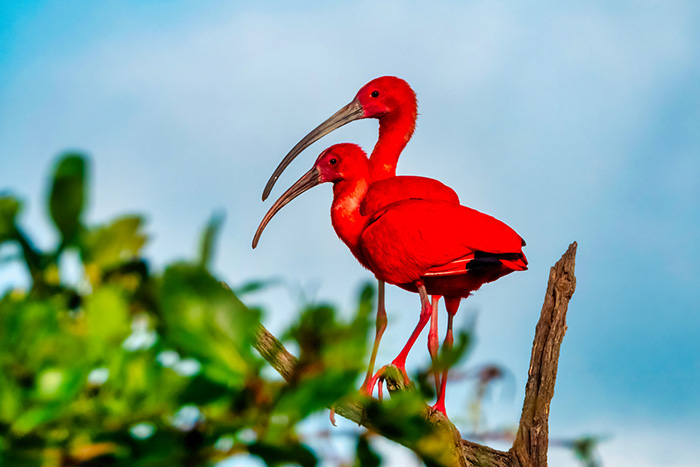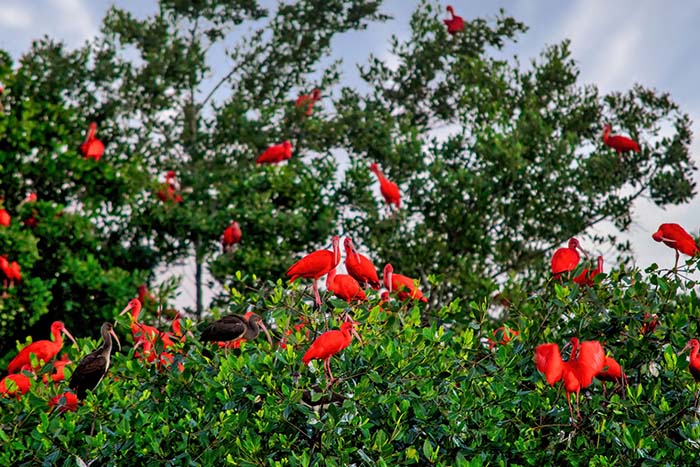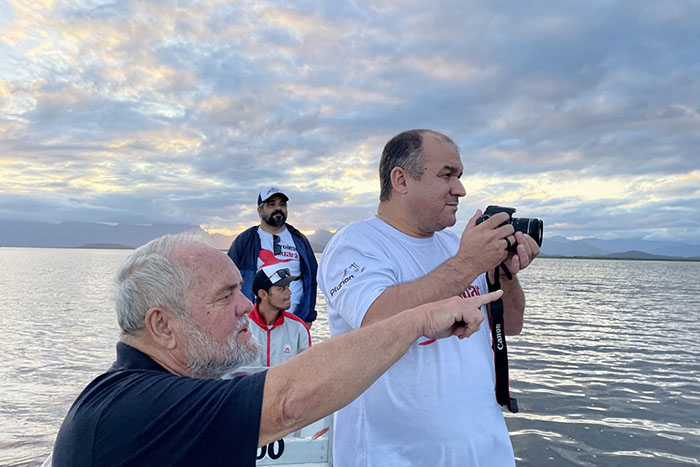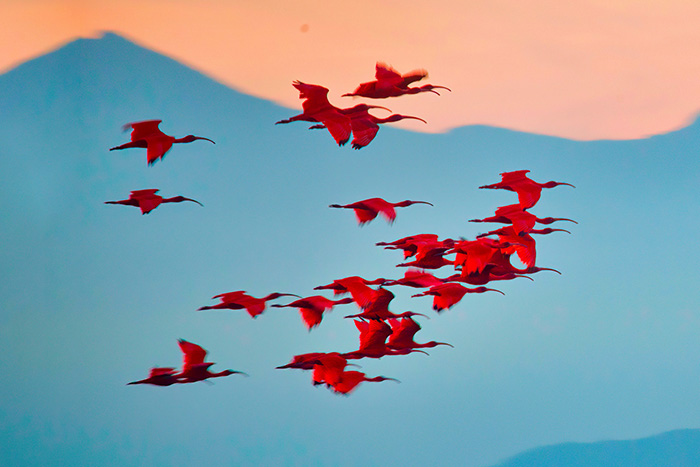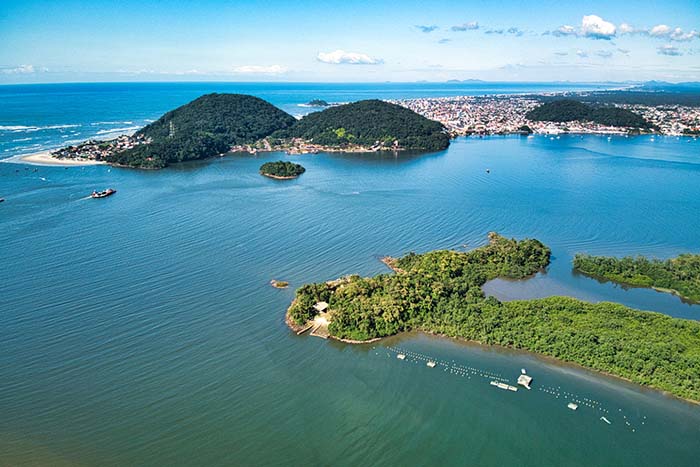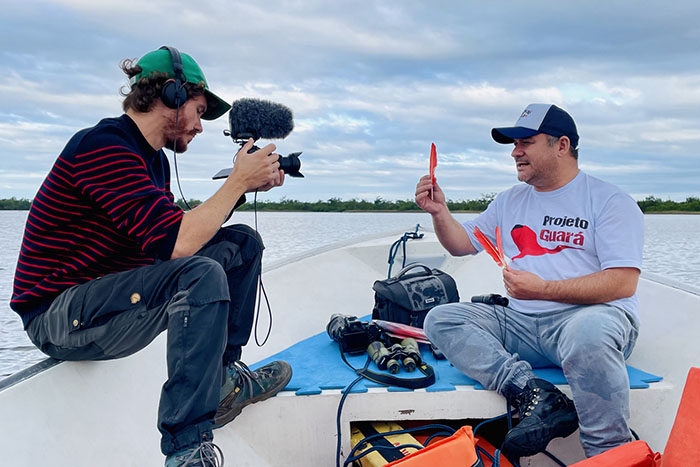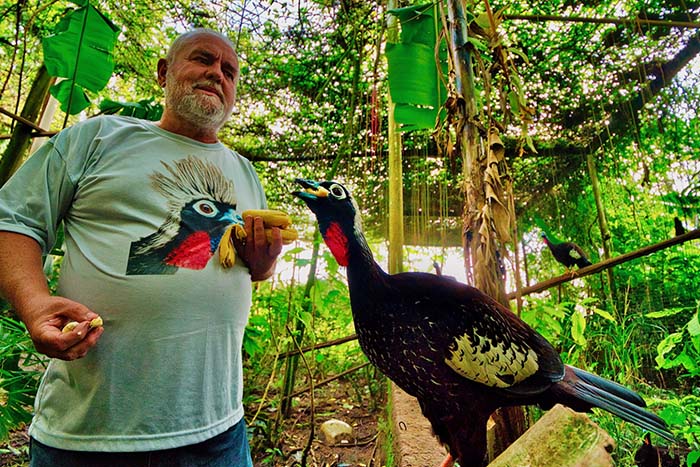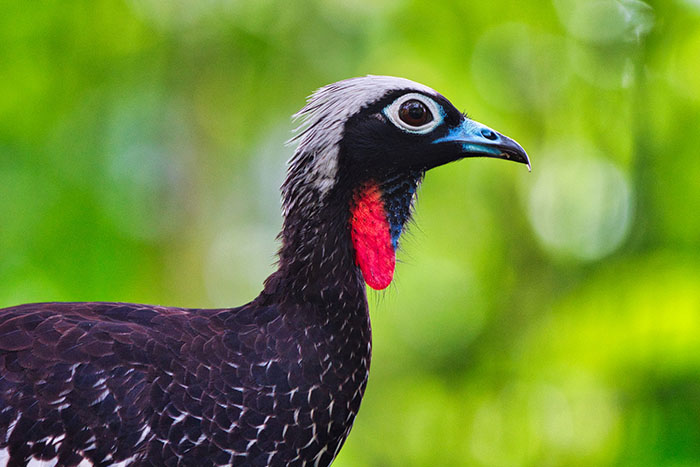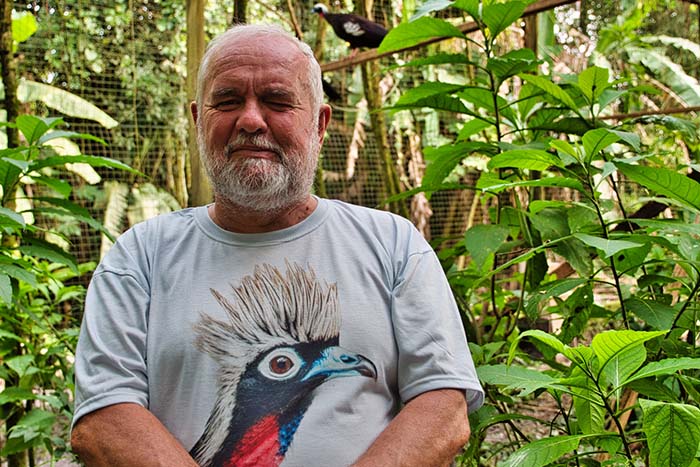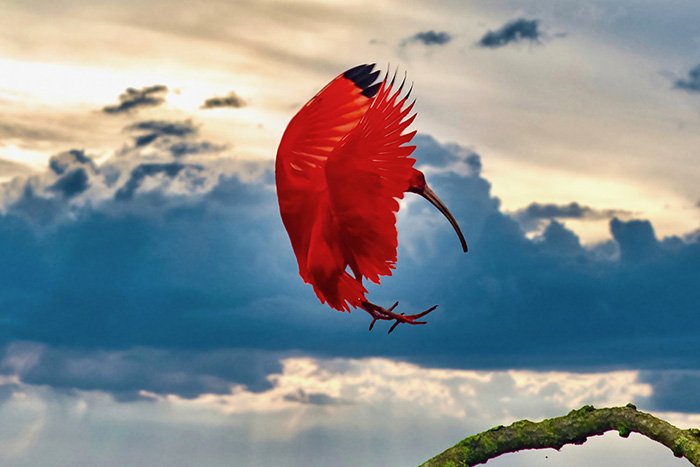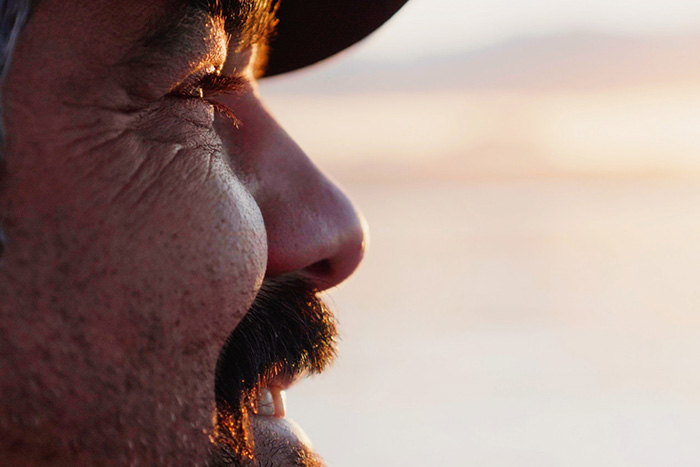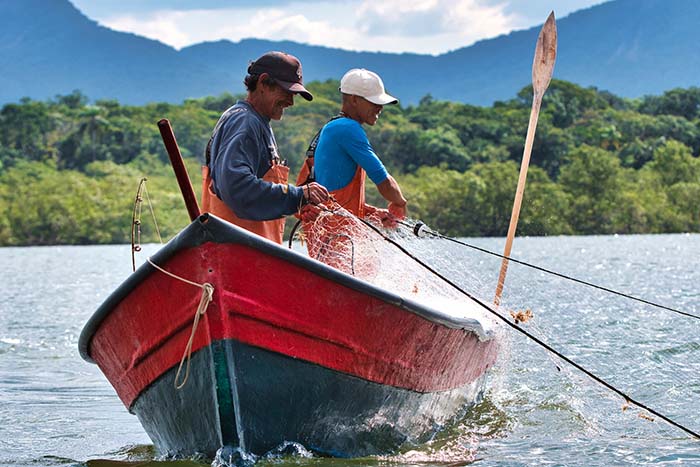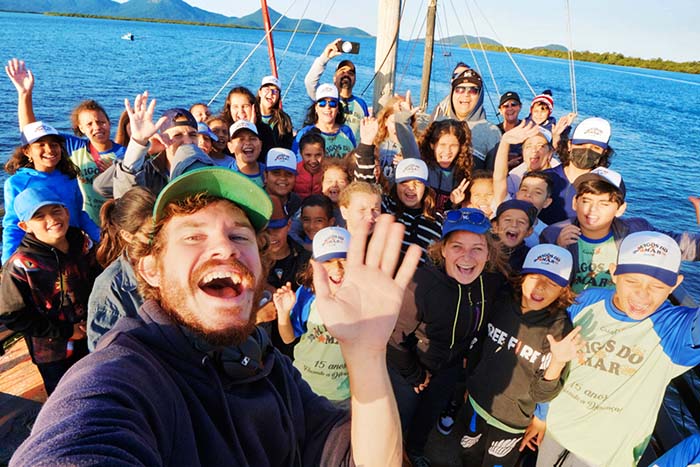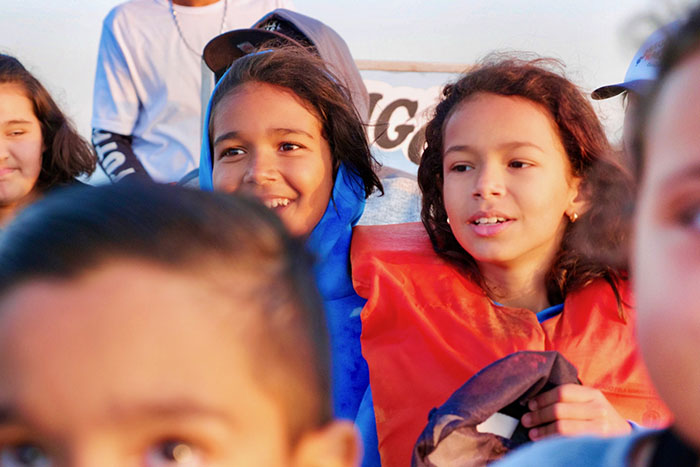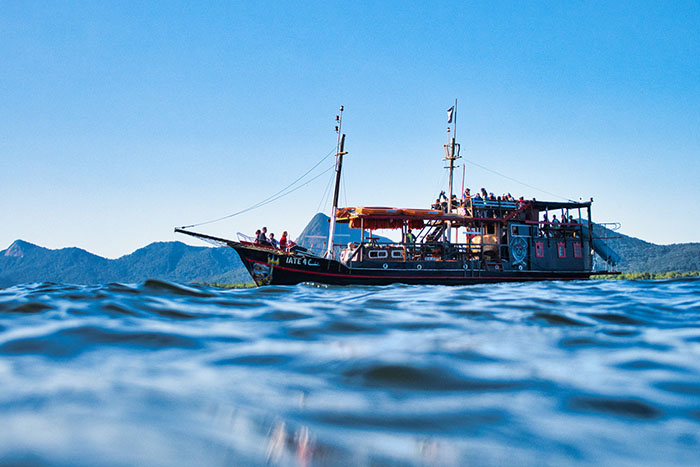Citizen Action⎢Brazil⎢2022
The come-back
of the Scarlet Ibis
In partnership with Instituto Guaju

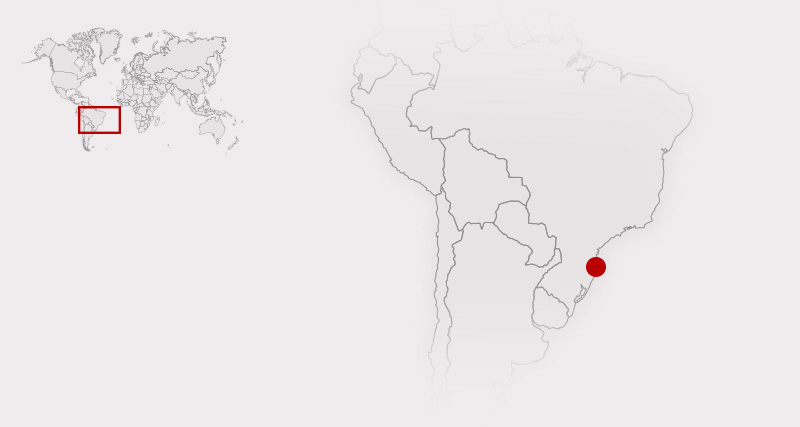
The Scarlet Ibis (Eudocimus ruber), called Guará in the locale native language, is a bird inhabiting South America and part of the Caribbean. It gave its name to the municipality of Guaratuba, literally “the place of many Guarás” in the local indigenous language. In Guaratuba, its existence is intimately linked to the state of the mangrove.
In the 1930s, its population died out completely following massive hunting. We document the efforts of the population of Guaratuba to maintain the extension of the mangrove and the quality of the water, and the conservation efforts undertaken by the Instituto Guaju, a citizen association for the preservation of biodiversity.

1832
The channel by which we went to and returned from Olinda, was bordered on each side by mangroves, which sprang like a miniature forest out of the greasy mud-banks. The bright green colour of these bushes always reminded me of the rank grass in a churchyard: both are nourished by putrid exhalations; the one speaks of death past, and the other too often of death to come.
It must be remembered that within the tropics, the wild luxuriance of nature is not lost even in the vicinity of large cities; for the natural vegetation of the hedges and hill-sides overpowers in picturesque effect the artificial labour of man.
– Charles Darwin, Voyage of the Beagle
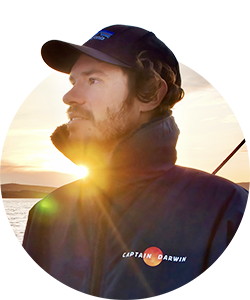
2022
The Brazilian mangrove, a recurring ecosystem of the Atlantic tropical forest, has seen its extension collapse with coastal urban development. The biodiversity associated with it has thus greatly diminished since the time of Darwin.
If the city of Guaratuba has always taken care of the mangrove that surrounds it, the Scarlet Ibis (Guarás) that inhabited it until the beginning of the 20th century were exterminated following the intensive trade in their feathers.
The efforts of the population of Guaratuba to preserve the extension of the mangrove and the quality of the water led to a natural return of the Scarlet Ibis at the beginning of the 21st century.

1832
The channel by which we went to and returned from Olinda, was bordered on each side by mangroves, which sprang like a miniature forest out of the greasy mud-banks. The bright green colour of these bushes always reminded me of the rank grass in a churchyard: both are nourished by putrid exhalations; the one speaks of death past, and the other too often of death to come.
It must be remembered that within the tropics, the wild luxuriance of nature is not lost even in the vicinity of large cities; for the natural vegetation of the hedges and hill-sides overpowers in picturesque effect the artificial labour of man.
– Charles Darwin, Voyage of the Beagle

2022
The Brazilian mangrove, a recurring ecosystem of the Atlantic tropical forest, has seen its extension collapse with coastal urban development. The biodiversity associated with it has thus greatly diminished since the time of Darwin.
If the city of Guaratuba has always taken care of the mangrove that surrounds it, the Scarlet Ibis (Guarás) that inhabited it until the beginning of the 20th century were exterminated following the intensive trade in their feathers.
The efforts of the population of Guaratuba to preserve the extension of the mangrove and the quality of the water led to a natural return of the Scarlet Ibis at the beginning of the 21st century.
The discovery of Guarás
The Guará is one of the most beautiful birds I have ever seen. With the team of the Instituto Guaju (a local environmental protection association), we explored the bay of Guaratuba in search of this magnificent ibis with red feathers (the common name of this species is the scarlet ibis ).
We explored the mangroves aboard the small motorboat of our new friends, Fabiano, Edgar and Marcos. Equipped with binoculars, they scrutinize the upper part of the mangroves, these trees with large roots that live with their feet in salt water. Suddenly, I hear a joyful cry: they are there!
Bright red contrasting against the saturated green background, a dozen Guarás are digesting their meal, perched on the tree like ripe fruit ready to pick. As we approach them as discreetly as possible, I observe better and better the details of their anatomy. The feathers are all red, except for the tips of the wings of a dark blue, almost black color. Their long curved bill is used to forage in the mud in search of food, their long legs allow them to stay above water level when the tide rises. I have very little time to photograph them, because the fearful birds take flight when they perceive the distant noise of our engine idling.
We continue our exploration to the Dormitorium, a small isolated island in the center of Guaratuba Bay, where all the Guarás of the region gather to sleep each night. It’s a little after 5:00 in the afternoon: the sky is darkening and taking on orange and red hues, as the sun gently descends behind the mountain ridges. Soon, hundreds of ibis appear from all directions, flying in small groups of about twenty.
Edgar, Fabiano and Marcos are as excited as children at the opening of Christmas presents. More and more birds arrive, flying above our heads to gracefully land on the branches of the mangrove trees. Our friends from the Instituto Guaju appreciate the spectacle all the more as the Guarás had completely disappeared from the bay for 80 years, before mysteriously returning a few years ago.
Hunting for red bright feathers
At the beginning of the 20th century, more and more Guarás were hunted for their magnificent bright red feathers, used to decorate the dresses of European women during the interwar period (between 1920 and 1930). In just a few decades, the entire bird population disappears. For the inhabitants of Guaratuba, it is a shock, especially since the name of the city comes precisely from the presence of the red ibis (Guaratuba literally means “the place where many Guarás are” in the local indigenous language ).
“It’s been 80 years since the bird disappeared, 80 years since we lost the emblem of our town”, Fabiano, Marcos and Edgar tell me. It was an episode that was all the more painful because Guaratuba has always been keen to protect its biodiversity. The city was founded in 1782 by European settlers, in an area that had already been occupied by native tribes for millennia. Ten years later, in 1792, the first environmental preservation law was passed to prevent overfishing.
In 1992, the entire bay was declared a nature reserve, with the aim of protecting biodiversity and preserving water quality. The region has never hosted heavy industry and has never been exploited for agriculture, as the land is not suitable for these activities (the mangrove is very humid and the soil is unstable). Finally, Fabiano tells me that the indigenous philosophy of intimate connection with Nature is still very much alive in the hearts of the inhabitants.
The Instituto Guaju is an association created by Fabiano, Marcos and Edgar, with a slightly crazy dream: to once again admire the graceful flight of the Guarás in the bay, after an 80-year disappearance. But how are they going to do it?
The reintroduction program
I have the honor to introduce you to Marcos, a bird enthusiast and one of the founding members of the Instituto Guaju. Marcos only cares about one thing: admiring the beauty of bird flight. “Why?”, I ask him as we visit an aviary he built, housing endangered birds destined to be released into the Wild. “I don’t know why I love them so much. They are part of our environment, we have a responsibility towards them, to help them live.”
Far from the Guarás that we admired the previous day, I am now surrounded by another species, the Jacutingas, magnificent black birds adorned with a black crest, bright red barbels and a beak with bluish reflections . Marcos breeds them here to ensure the species does not go extinct in the area. Not so long ago, another part of the aviary was supposed to house Guarás… but the birds never came, and today only a large empty cage of about 30 square meters remains.
Indeed, in 2008, everything was ready to welcome the Guarás in the bay of Guaratuba. Although the species had disappeared from the region at the beginning of the 20th century, several population centers still existed in the country. With Edgar and Fabiano from the Instituto Guaju, and in collaboration with the University of Paraná, Marcos’ plan was very simple: bring in Guarás from northern Brazil, put them in the aviary while they adapt , then release them into the wild.
A few days before the birds arrive in the aviary, the unthinkable happens: a breathless fisherman comes to see Marcos. “I…saw…a…Guará!” A Guará has been spotted in the bay!! But how did this bird end up there, all alone?
The great come-back of the scarlet ibis
With Fabiano and Marcos from the Instituto Guaju, we return to the exact place where the first Guará was observed, on that memorable day of June 23, 2008. On board a small wooden boat, advancing silently with the help of t a simple paddle, we approach a mud bank where a scarlet ibis feeds peacefully.
Fabiano and Marcos remember this day with emotion. “It was an ornithological orgasm!” writes Marcos, his eyes laughing. “After spending a lifetime listening to elders tell stories of Guarás, we can finally enjoy the spectacle with our own eyes!” Indeed, the contrast between the gleaming feathers of the bird and the gray of the mud bank is striking, almost unreal.
“How could he come back to Guaratuba on his own?” I ask Fabio. “We believe that several individuals made their way from a colony near São Paulo. The Guarás are sedentary birds, but they fly very well otherwise. A few individuals arrived first, then a whole population moved in. “has been replenished over the years. There are now more than 4000 Guarás in the bay! What has been decisive is that they have found a preserved environment here, less impacted by human activities than the rest of the country .”
The nature preservation policy applied by the city since the end of the 18th century could not prevent the disappearance of the species in 1920. But it has contributed, over the years, to maintaining a healthy and excellent water quality, which allowed the development of the bird population after the unexpected arrival of several individuals in Guaratuba.
The inhabitants of the city have obviously succeeded in establishing a harmonious relationship with the biodiversity of the region. Fishermen use small boats inside the bay, while larger vessels fish for shrimp outside. The city is concentrated on the southern shore, leaving most of the bay in its natural state. Today, everyone can easily admire the flight of scarlet ibises: the dream of Marcos, Edgar and Fabiano has come true.
Sharing with the youth
Let’s go admire the Guarás with the children! One of the goals of Instituto Guaju, now that the Guarás have returned to Guaratuba, is to ensure that everyone can enjoy the spectacle of the bay’s most famous bird. Thus, they regularly organize trips to the sea for schoolchildren in the city, an initiative appropriately called “Amigos do Mar” (friends of the sea).
Aboard a pirate ship rented for the occasion, we sail with about forty schoolchildren to the Dormitorium, the island that we explored a few days ago and where the ibises sleep every night. As the Guarás fly above our heads, the children let out loud cries of wonder, their eyes wide open and a huge smile from ear to ear.
Ícario is one of them. As we slowly approach the birds, I ask him how he feels. “I’m so excited to see them!” For him and most of his comrades, seeing the Guarás up close is a great first. “They turn red from eating Caranguejos, small purple crabs that they find in the mud with their long beaks. That’s why the young are still gray while the adults are red!”. I am impressed with the knowledge of these young people.
“The closer they are to Nature, the more they will defend biodiversity as adults”, confides to me Fabiano, who takes part in the expedition with undisguised pleasure. While we wait for more birds to arrive, Cécile tells the children the story of Captain Darwin, and how we sailed from England to be with them today. Fabiano takes the opportunity: “You see, children, in life, everything is possible, for boys as for girls. You have to believe in your dreams!”.
We return to Guaratuba with new friends, and a reinforced certainty: a better knowledge of Nature and an emotional relationship with it are the keys to a sustainable society.



Donate
Help us spread the word about biodiversity by supporting our Patreon!
Social Networks
Follow Captain Darwin on Social Networks to follow our adventures!
Send an email
A question? Something to say? A word of encouragement? Send us an email!
© Captain Darwin 2023 - 1 rue des Senneurs - 29 900 Concarneau - FRANCE

